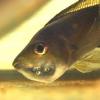I’m coming to this discussion late, but thought I might be able to contribute a couple of ideas that may challenge people’s thinking a little.
1 - The quest for “new blood”
This is something that concerns me a lot – the recent preoccupation with chasing “new blood lines”. Don’t get me wrong – I’m NOT saying that in-breeding isn’t something that needs to be considered when making breeding decisions, but I feel the "issue" is significantly overplayed and needs to be approached in a balanced way.
The situation with in-breeding in fish just isn’t the same as it is with mammals. If you are keen, there are some really good research papers available that look at the extent of in-breeding that occurs in wild populations of fish. There is one on Tanganyikan multies which shows how closely related wild breeding groups are using DNA testing. Similar studies have been done on other cichlid species. Reality is that in-breeding in wild populations is significant. There is also heaps of data that shows that “out-breeding depression” is every bit as much of a problem in fish populations as “in-breeding depression” is. Much of that research has been done by the aquaculture industry. Google the topic – some interesting, if somewhat heavy, reading. But it’s not just research papers - most experienced breeders will have stories of the odd outcomes they’ve had from out-crosses they’ve tried.
I’ve seen firsthand the situation with some fish in the wild in Lake Malawi. Many of the species there are found in very small numbers in very isolated places. To see a species which is found only on one tiny island or reef (small enough to be able to swim around in a few minutes) , and is isolated to a band of a few metres in depth only, and you realise just how few fish of that species exist, and just how small the genetic diversity of the wild population is.
Examples can be found in our hobby, too, of species which arrived in Australia decades ago, and were only ever brought here in one or two importations containing very few fish. All of the stock in this country now trace back to that handful of fish, but where those fish have been kept in the hands of dedicated hobbyists, they are still producing fabulous quality offspring, despite no introductions of “new blood” after many, many generations.
One MAJOR problem with looking for “new” lines is that every time you bring fish in from another source you increase the likelihood of introducing a hybrid. It only takes one crook fish introduced into your stock to completely destroy pure lines. This is what we are finding with Malawis – yes people say they have species AAA or BBB, but look closely and all have been corrupted at some time in the past – often by that quest for “new blood”. And more often than not, when people chase “new lines”, it can be shown that they all come from the same source one or two generations back anyway.
Even without considering the ever present risk of introducing hybrids - the fish you are producing will generally only be as good as the poorer of their parents. It becomes a balancing act – if all you can obtain is poorer quality fish in chasing “new lines”, then you aren’t necessarily doing the right thing by your fish. Let’s be honest, with the rise of the “get rich quick” breeders in the hobby in recent years, it’s hard to find ANY decent stock of many species, let alone good quality, unrelated stock from multiple sources.
I reiterate - I’m not saying don’t chase new lines. I’m saying it needs to be done with thought, research and real caution. You need to take a balanced approach. If you have top quality fish which are producing good quality fry, you need to be really careful about introducing problems into your group.
2 - Colony Size
I personally think that the way we keep our fish has a far more significant impact on the outcomes from our breeding than “in-breeding depression”.
In the wild there is natural selection. Many fry are spawned. There is competition for food, so the larger, stronger fry out compete the weaker ones, and only the strong survive. There is pressure from predators. The slower, dumber fish get wiped out, while the fast, wily ones survive. From those that survive to adulthood, there is then competition for mates. Only the best males get to breed with the fussy females. OK – a simplistic description – but you get the idea.
In the aquarium we provide a false environment. If we do our job well most of the fry we breed survive to adulthood. People buy these fish in twos and threes – the good strong ones AND the runts. If there is any “selection” by the buyer, it’s only from what’s left in the tank at the time of sale, but usually it’s no more than “lucky-dip” – first fish in the net. This means that EVERY fish in the brood becomes a potential breeding prospect. With a single male in a tank with one or two females there is no “natural selection”. The one male breeds with whatever is available in the way of females.
From all the reading I’ve done, I’ve worked out my approach. I breed Malawis, primarily haps and mbuna. This approach isn’t necessarily appropriate for all cichlid species, but its worked well for me.
For a species I intend to breed, I buy larger numbers of juvis and grow them up together. I’m striving to establish a decent sized colony with multiple males if it’s at all possible. I’ll source stock from multiple sources if good stuff is available, but my PRIMARY focus is on getting the best quality I possibly can. If I can only source good fish from one source, that’s what I’ll work with.
As the fish mature, I remove any fish that don’t come up to scratch. I then let the fish decide who breeds and who doesn’t. Watching a colony, dominant males get all of the action, and you find that there are usually a few females which breed far more often than others. Some females never breed.
Since using this approach I’m finding that deformed fry are pretty well non-existent. The only suspect fry I’m getting these days are from a few older pairs / trios I have, or can be traced back to an environmental impact while fry were young.
I’m certain some people will disagree with what I’m saying. Just putting my thoughts out there in case it helps others to perhaps think a little deeper.
Edited by humbug, 18 May 2016 - 09:56 AM.
















